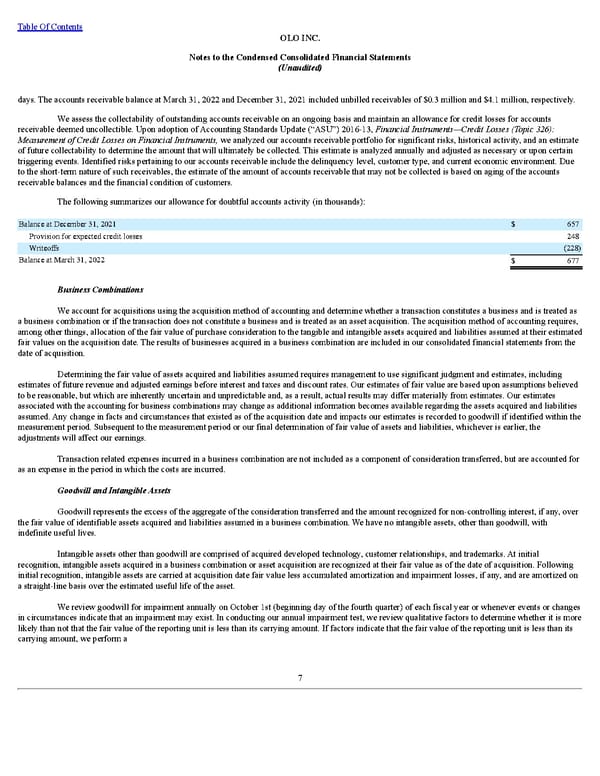Table Of Contents OLO INC. Notes to the Condensed Consolidated Financial Statements (Unaudited) days. The accounts receivable balance at March 31, 2022 and December 31, 2021 included unbilled receivables of $0.3 million and $4.1 million, respectively. We assess the collectability of outstanding accounts receivable on an ongoing basis and maintain an allowance for credit losses for accounts receivable deemed uncollectible. Upon adoption of Accounting Standards Update (“ASU”) 2016-13, Financial Instruments—Credit Losses (Topic 326): Measurement of Credit Losses on Financial Instruments, we analyzed our accounts receivable portfolio for significant risks, historical activity, and an estimate of future collectability to determine the amount that will ultimately be collected. This estimate is analyzed annually and adjusted as necessary or upon certain triggering events. Identified risks pertaining to our accounts receivable include the delinquency level, customer type, and current economic environment. Due to the short-term nature of such receivables, the estimate of the amount of accounts receivable that may not be collected is based on aging of the accounts receivable balances and the financial condition of customers. The following summarizes our allowance for doubtful accounts activity (in thousands): Balance at December 31, 2021 $ 657 Provision for expected credit losses 248 Writeoffs (228) Balance at March 31, 2022 $ 677 Business Combinations We account for acquisitions using the acquisition method of accounting and determine whether a transaction constitutes a business and is treated as a business combination or if the transaction does not constitute a business and is treated as an asset acquisition. The acquisition method of accounting requires, among other things, allocation of the fair value of purchase consideration to the tangible and intangible assets acquired and liabilities assumed at their estimated fair values on the acquisition date. The results of businesses acquired in a business combination are included in our consolidated financial statements from the date of acquisition. Determining the fair value of assets acquired and liabilities assumed requires management to use significant judgment and estimates, including estimates of future revenue and adjusted earnings before interest and taxes and discount rates. Our estimates of fair value are based upon assumptions believed to be reasonable, but which are inherently uncertain and unpredictable and, as a result, actual results may differ materially from estimates. Our estimates associated with the accounting for business combinations may change as additional information becomes available regarding the assets acquired and liabilities assumed. Any change in facts and circumstances that existed as of the acquisition date and impacts our estimates is recorded to goodwill if identified within the measurement period. Subsequent to the measurement period or our final determination of fair value of assets and liabilities, whichever is earlier, the adjustments will affect our earnings. Transaction related expenses incurred in a business combination are not included as a component of consideration transferred, but are accounted for as an expense in the period in which the costs are incurred. Goodwill and Intangible Assets Goodwill represents the excess of the aggregate of the consideration transferred and the amount recognized for non-controlling interest, if any, over the fair value of identifiable assets acquired and liabilities assumed in a business combination. We have no intangible assets, other than goodwill, with indefinite useful lives. Intangible assets other than goodwill are comprised of acquired developed technology, customer relationships, and trademarks. At initial recognition, intangible assets acquired in a business combination or asset acquisition are recognized at their fair value as of the date of acquisition. Following initial recognition, intangible assets are carried at acquisition date fair value less accumulated amortization and impairment losses, if any, and are amortized on a straight-line basis over the estimated useful life of the asset. We review goodwill for impairment annually on October 1st (beginning day of the fourth quarter) of each fiscal year or whenever events or changes in circumstances indicate that an impairment may exist. In conducting our annual impairment test, we review qualitative factors to determine whether it is more likely than not that the fair value of the reporting unit is less than its carrying amount. If factors indicate that the fair value of the reporting unit is less than its carrying amount, we perform a 7
 Q1 2022 10Q Page 10 Page 12
Q1 2022 10Q Page 10 Page 12